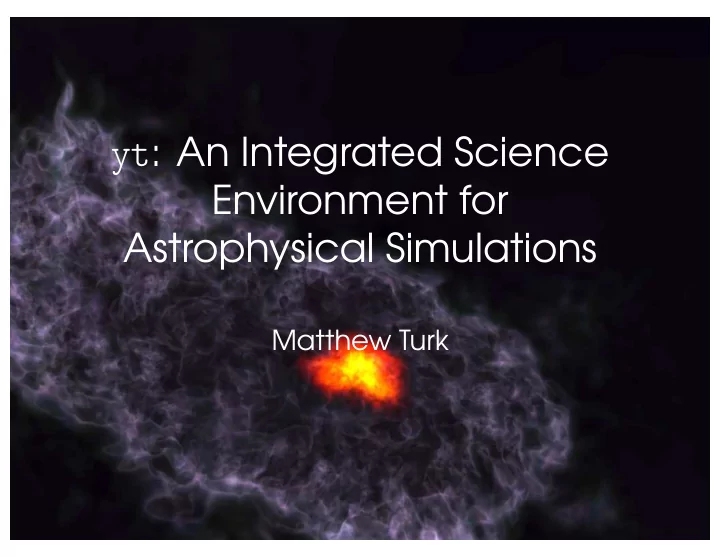

yt : An Integrated Science Environment for Astrophysical Simulations Matthew Turk
There is only one sky. (but there are many simulation codes)
Different methods, data structures, assumptions, IO methods, units, variable names, ...
Analysis.
astro-ph/1011.3514 yt-project.org
install script: Full dependency stack Source code Development environment GUI Sample data
yt has been designed to address physical, not computational, entities.
The Universe is full of gas, dark matter and stars. yt makes it easy to access that material.
Transparent IO, masking of overlapping data, load-on-demand, geometric and non- geometric selection, field generation, and common interfaces to different datatypes.
Enzo, Orion, CASTRO, FLASH Chombo, Tiger, Athena , ART, RAMSES yt is designed to be the lingua franca of astrophysical codes.
Objects Orthogonal Rays 1D Non-orthogonal Rays Slices Oblique Slices 2D Projections Spheres Rectangular Prisms Disks/Cylinders Inclined Boxes 3D Clumps Extracted Regions Boolean combinations
from yt.mods import * pf = load(’galaxy0030/galaxy0030’) p = SlicePlot(pf, 2, ’Density’, ’c’, (200,’kpc’)) p.save(’Galaxy’)
from yt.mods import * pf = load(’galaxy0030/galaxy0030’) p = SlicePlot(pf, 2, ’Density’, ’c’, (200,’kpc’)) p.set_width(20, ’kpc’) p.save("GalaxyZoom")
from yt.mods import * pf = load(’galaxy0030/galaxy0030’) p = ProjectionPlot(pf, 2, ’Density’, ’c’, (20,’kpc’)) p.save(’Galaxy’)
Volume Rendering
Designed around integrating through a volume: visualization is a side effect. dI ν ds = j ν − α ν I ν
10 -14 g/cc
Canned Analysis Tasks
Absorption Spectrum Coordinate Transformations Halo Finding Mass Functions Merger Trees Halo Profiling Level Sets Light Cones Light Rays Time Series Star Analysis Two-Point Analysis
Level Sets
Synthetic Spectra
Two-Point Functions
Parallelism
Multi-level parallelism: dynamic workgroups, communicators, subgroups and task queues
Parallelism Embarassingly Parallel Spatial Decomposition Decomposed by load or Helper functions to IO characteristics decompose the domain
Parallelism Embarassingly Parallel Spatial Decomposition Quantities Profiles Slices Halo Finding Projections Volume Rendering
Developing as a Team
Forky development: very low barrier to entry; everything comes in the box.
Testing: answer as well as integration tests get run every 30 minutes.
Community ◮ Mailing lists: community, development ◮ IRC ( #yt on irc.freenode.net ) ◮ Cookbook, docs ◮ Curriculum from workshop
2
80,000 lines of code Python, Cython, C 20 contributors (60+ users) Contributors from 10+ institutions 8AM 6PM
Contributors Tom Abel Jean-Claude Passy David Collins Thomass Robitaille Andrew Cunningham Anna Rosen Nathan Goldbaum Anthony Scopatz Cameron Hummels Devin Silvia Ji-hoon Kim Sam Skillman Stephen Skory Steffen Klemer Kacper Kowalik Britton Smith Michael Kuhlen Geoffrey So Eve Lee Casey Stark Chris Malone Elizabeth Tasker Chris Moody Rick Wagner John Wise Andrew Myers Jeff Oishi John ZuHone
yt 3.0
No more grids, only chunks
Particle segregation, multiple fluids
Address technical debt
Strategies ◮ Patch: chunks are collections of grids ◮ Octree: direct octree parsing ◮ SPH/N-body: octree indexing
3.0 Milestones 1. Patch-based analysis and 2D viz 2. Patch-based volume rendering 3. Halo Finding 4. Octree analysis and 2D viz 5. Particle analysis and 2D viz
Caveats!
SPH Support ◮ Particle support only at first ◮ No first light (ETA: 3-6 weeks) ◮ Many free parameters, many output formats
Octree Support ◮ Volume rendering not ready yet ◮ Subtleties may lurk ◮ ART half-finished
I volunteer!
(demo)
Thank you. yt-project.org
Recommend
More recommend